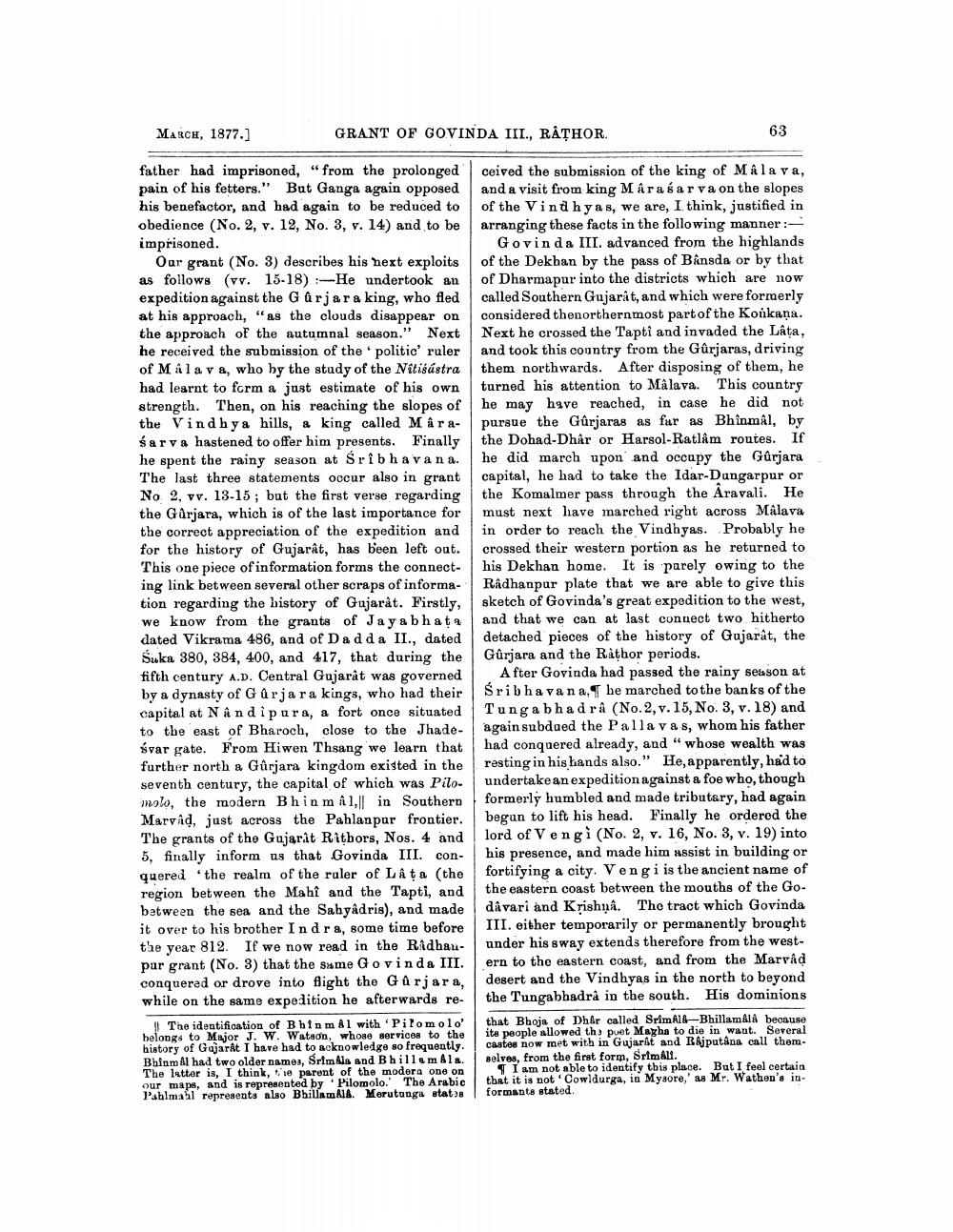________________
March, 1877.]
GRANT OF GOVINDA III., RÅTHOR.
63
father had imprisoned, “from the prolonged pain of his fetters." But Ganga again opposed his benefactor, and bad again to be reduced to obedience (No. 2, v. 12, No. 3, v. 14) and to be imprisoned.
Our grant (No. 3) describes his next exploits as follows (vv. 15-18) -He undertook an expedition against the Gürjara king, who fled at his approach, "as the clouds disappear on the approach of the autumnal season." Next he received the submission of the politic' ruler of Mala v a, who by the study of the Nitiśástra had learnt to form a just estimate of his own strength. Then, on his reaching the slopes of the Vindhya hills, a king called Maraśarva hastened to offer him presents. Finally he spent the rainy season at Sribhavana. The last three statements occur also in grant No 2, vv. 13-15; but the first verse regarding the Gârjara, which is of the last importance for the correct appreciation of the expedition and for the history of Gujarat, has been left out. This one piece of information forms the connecting link between several other scraps of information regarding the history of Gujarat. Firstly, we know from the grants of Jay a bhata dated Vikrama 486, and of Dadda II., dated Suka 380, 384, 400, and 417, that during the fifth century A.D. Central Gujarat was governed by a dynasty of Gurjara kings, who had their capital at Nandipura, a fort once situated to the east of Bharoch, close to the Jhadesvar gate. From Hiwen Thsang we learn that further north a Gurjara kingdom existed in the seventh century, the capital of which was Pilomolo, the modern Bhinmal,ll in Southern Marvad, just across the Pahlanpur frontier. The grants of the Gujarat Ritbors, Nos. 4 and 5, finally inform us that Govinda III. conquered the realm of the ruler of LÀ ţa (the region between the Mahî and the Tapti, and between the sea and the Sahyadris), and made it over to his brother Indra, some time before the year 812. If we now read in the Radhaupar grant (No. 3) that the same Govinda III. conquered or drove into fight the Garjara, while on the same expedition he afterwards re
The identification of Bhinmal with Pilomolo' belongs to Major J. W. Watson, whose services to the history of GajarAt I have had to acknowledge so frequently. Bhinm Al had two older names, Srim Ala and Bhillem Ala The latter is, I think, le parent of the modora one on our maps, and is represented by Pilomolo.' The Arabic Pahlmahl represents also BhillamAlA. Merutunga stats
ceived the submission of the king of Mala va, and a visit from king Mâras ar va on the slopes of the Vindhyas, we are, I think, justified in arranging these facts in the following manner :
Govinda III. advanced from the highlands of the Dekban by the pass of Bansda or by that of Dharmapur into the districts which are now called Southern Gujarât, and which were formerly considered thenorthernmost part of the Konkana. Next he crossed the Tapti and invaded the Lâta, and took this country from the Gurjaras, driving them northwards. After disposing of them, he turned his attention to Mâlava. This country he may have reached, in case he did not pursue the Gurjaras as far as Bhinmal, by the Dohad-Dhår or Harsol-Ratlâm routes. If he did march upon and occupy the Gurjara capital, he had to take the Idar-Dungarpur or the Komalmer pass through the Aravali. He must next have marched right across Mâlava in order to reach the Vindhyas. Probably he crossed their western portion as he returned to his Dekhan home. It is parely owing to the Radhanpur plate that we are able to give this sketch of Govinda's great expedition to the west, and that we can at last connect two hitherto detached pieces of the history of Gujarât, the Gurjara and the Rathor periods.
After Govinda had passed the rainy season at Šribhavana, he marched to the banks of the Tunga bhadrâ (No.2, v.15, No. 3, v. 18) and again subdued the Palla vas, whom his father had conquered already, and "whose wealth was resting in his hands also.” He, apparently, had to undertake an expedition against a foe who, though formerly humbled and made tributary, had again began to lift his head. Finally he ordered the lord of Vengi (No. 2, v. 16, No. 3, v. 19) into his presence, and made him assist in building or fortifying a city. Vengi is the ancient name of the eastern coast between the mouths of the Godåvari and Krishņâ. The tract which Govinda III. either temporarily or permanently brought under his sway extends therefore from the western to the eastern coast, and from the Marvad desert and the Vindhyas in the north to beyond the Tungabhadra in the south. His dominions that Bhoja of Dhếr called SrimAll-Bhillamåla because its people allowed th> puet Magha to die in want. Several castee now met with in Gujarat and Bajputana call them. solves, from the first form, Srimall.
1 I am not able to identify this place. But I feel certain that it is not Cowldurga, in Mysore,' as Mr. Wathen's informanta stated




